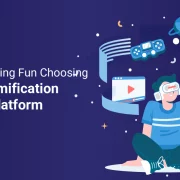This expression relates to player incentive ideas, such as rewards, to raise student participation. As gamification elements in training, the learners’ scores may be shown to them so they could compare their performance to that of other participants. Other gamification elements include medals and badges, which are awarded after actions are complete.
Training can employ strategies for motivating without the use of games to teach.
Q: What is Gamification?
A: It is the practice of integrating game mechanics and design ideas into non-game situations, such as business, education, or social effect, in order to engage and inspire individuals to carry out a certain action.
Q: What are the benefits?
A: It can boost motivation, retention, and engagement while also encouraging competitiveness and teamwork and enhancing decision-making and problem-solving abilities.
Q: What are some examples?
A: Since they use points, badges, leaderboards, and other game components to promote desired behaviors, gamification can be seen in loyalty programs, fitness apps, educational games, and workplace productivity tools.
Q: How can businesses use it?
A: Businesses can use gamification to drive customer engagement with their products or services, award employees for achieving company goals, and enhance productivity and teamwork.
Q: How can educators use it?
A: Teachers can use gamification to design interactive and interesting lessons, inspire students to finish tasks and learn new material, and give rapid feedback and encouragement.
Q: What are some challenges of implementing?
A: Designing efficient game rules, ensuring that incentives are substantive and not merely cosmetic, and avoiding an excessive reliance on extrinsic motivators are some of the challenges associated with implementing gamification.
Q: How can it be used for social impact?
A: Gamification can have a beneficial social influence by inspiring people to engage in healthy habits like recycling, energy conservation, and charitable giving as well as through raising awareness of and educating people about social concerns.
Q: Is it suitable for all contexts?
A: Gamification is useful in many circumstances, but it might not be appropriate in every circumstance. While developing gamification methods, educators and organizations should take the particular requirements and preferences of their audience into account.
Q: What is the future?
A: With ongoing technological improvements and research that supports its efficacy in fostering engagement, motivation, and behavior change, it has a bright future.



